11232 A LARGE PAIR OF WHITE OPALINE GLASS AND POLYCHROME ENAMEL VASES IN THE ‘ETRUSCAN’ STYLE Probably St. Petersburg. Circa 1840. Measurements: Height: 25″ (63.5 cm) Diameter: 9″ (23 cm).
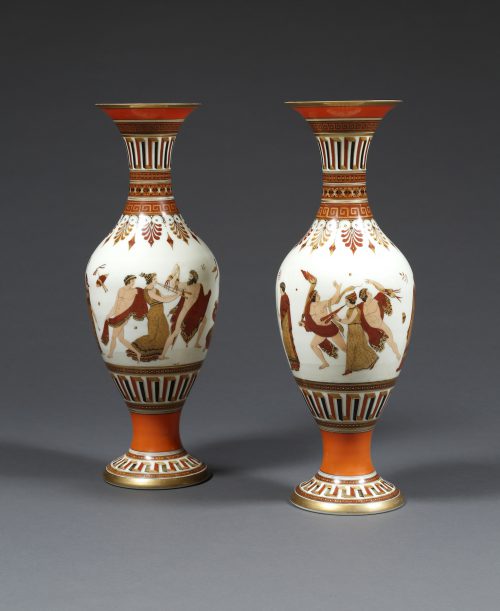
Research
Of white opaline glass and colored enamels. The ovoid body mounted by a flared neck and supported by a socle resting on a square plinth. The neck and foot of each vase decorated with registers of greek key and other geometric designs, the shoulder decorated with alternating anthemion and lozenge motifs, and the body of each decorated with different vignettes depicting classical male and female musicians and dancers.
Provenance:
A South Of England UK Collection
The glass industry in Russia during the nineteenth century was characterized by technological innovation and rapid expansion. The import of foreign glass was banned,1 and therefore the establishment of domestic glassworks was encouraged. The Imperial Glass Factory at St. Petersburg, officially founded as a state factory in 1792, was the leading workshop in Russia, producing “art pieces to be presented to the Imperial Court or to be granted to private individuals and institutions on behalf of the Monarch from His Majesty’s Cabinet.”2 It was unrivaled in the production of colored glass both in Russia and throughout Europe.
The extensive manufacture of colored glass accompanied an interest in revival styles (historicism) as well as exotic cultures, and a range of forms and decorative motifs covering a variety of periods and fashions were produced, including Islamic, Gothic, Etruscan, and Chinoiserie. The use of opal glass, also referred to as “milk” or “bone glass,” was particularly employed in these instances. The painting of glass was executed under the supervision of Pytor Neupokoyev, master of ‘painting and making up chemical paints,’ as well as the painter Vasily Solodovnikov and his eight apprentices. The decoration of glass objects came from a variety of sources; “an inventory of the painting workshop in 1792 lists a large number of French prints from ‘Herculaneum’ books (i.e., publications of wall paintings found during the excavations of Pompeii and Herculaneum) and other works devoted to similar subjects.”3
The present pair of vases is representative of the Etruscan (or “Pompeian”) style made in imitation of red-figure and black-figure vase painting in Russia from the 1830s onward. “In the course of work on interior décor in various styles of Historicism…architects and artists carefully selected and elaborated decoration techniques for appropriate objects of virtue to match particular styles.”4 This vogue was expressed in the tastes of the Imperial family, for example, in the Pompeian (or Small) Dining Room of the Winter Palace designed by Alexander Bruillov in the 1830s, and depicted in a watercolor by Konstantin Ukhtomsky circa 1874 (figure 1). A further example is the Pompeian-style Tsarina Pavilion at Peterhof Palace, built between 1842-44 by the architect Andrei Stackenschneider for Empress Alexandra Feodorovna in the style of an ancient villa, whose architecture and decorative contents included original excavated Pompeian floor mosaics and a large “Etruscan” breakfast and luncheon service created by the Imperial Porcelain Manufactory in 1844.
Several “Etruscan” milk glass pieces made by the Imperial Glassworks, are contained today in state collections, as well as a few of the royal residences. Numbering among these is an impressive vase of ancient crater form in the Peterhof State Museum Reserve decorated with polychrome enamel figures harnessing a chariot. Others include a traditional amphora-form vase circa 1836-39 painted in red with a domestic scene, after a drawing by Bruillov, in the State Hermitage Museum (figure 2), and a vase painted with a classical allegorical portrait of Alexander I circa the 1840s in the Hermitage collection (figure 3). One of the most relevant to the present examples, however, is an Etruscan style vase in the State Hermitage Museum decorated by classical figures and Greek key motifs painted predominantly in red, beige, and black with gilding (figure 4). It bears figures drawn in the same style surrounded by suspended objects and is embellished with Greek key and other geometric patterns.
The present vases, however, are significantly larger and more elaborately decorated. Each appears to illustrate a celebratory procession of musicians and dancers, with symbolism indicating it may be in honor of Dionysus. Some members of each party carry instruments including the double aulos, or reed flute, while others carry torches, decorative staffs, and vessels. The majority of male figures hold what can most likely be identified as taeina, sashes with (in this instance) bulbous, tasseled ends. Numerous ancient vessels include this type of textile, including an Apulian red-figure amphora in the British Museum circa 350 BC (figure 5). The figures were also inspired by ancient Greek vase painting, in which similar vignettes can be found. For example, a 4th century BC pelike in the British Museum depicts a seated figure with libation dish receiving a wreath from a leaning figure (figure 6). The manner in which the figures are rendered, as well as the color palette, relates most closely to white ground vases of the 5th century BC.
Footnotes:
1. Asharina, N A, T Malinina, and L Kazakova. Russian Glass of the 17th-20th Centuries. Corning, N.Y: Corning Museum of Glass, 1990. 29.
2. Malinina, T, and A V. Mineeva. Imperial Glass Factory, 1777-1917 : 225th Foundation Day anniversary : catalogue of exhibition. Sankt-Peterburg: Slavii︠a︡, 2004. 6.
3. Asharina, 25.
4. Malinina, 70.

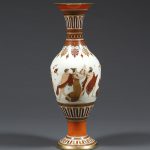


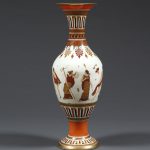
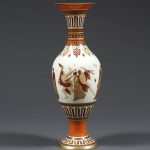

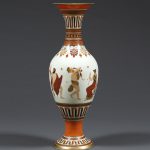
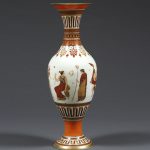

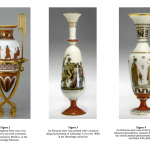

Comments are closed.